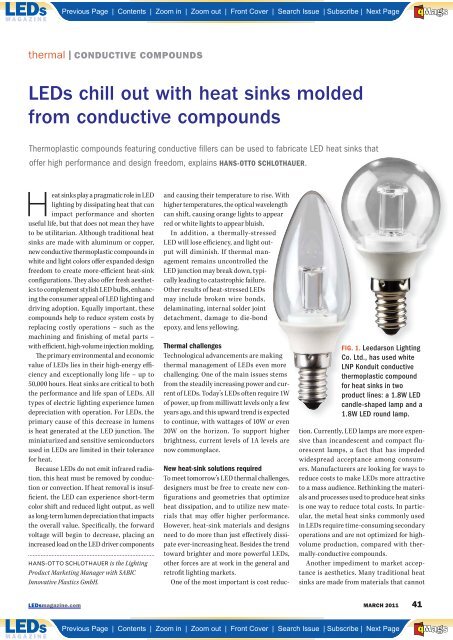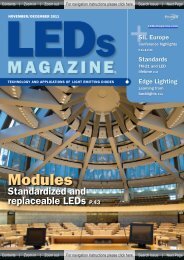Luminaires
Luminaires
Luminaires
- No tags were found...
You also want an ePaper? Increase the reach of your titles
YUMPU automatically turns print PDFs into web optimized ePapers that Google loves.
Previous Page | Contents | Zoom in | Zoom out | Front Cover | Search Issue | Subscribe | Next PageABE FMaGSthermal | CONDUCTIVE COMPOUNDSLEDs chill out with heat sinks moldedfrom conductive compoundsThermoplastic compounds featuring conductive fi llers can be used to fabricate LED heat sinks thatoffer high performance and design freedom, explains HANS-OTTO SCHLOTHAUER.Heat sinks play a pragmatic role in LEDlighting by dissipating heat that canimpact performance and shortenuseful life, but that does not mean they haveto be utilitarian. Although traditional heatsinks are made with aluminum or copper,new conductive thermoplastic compounds inwhite and light colors offer expanded designfreedom to create more-efficient heat-sinkconfigurations. They also offer fresh aestheticsto complement stylish LED bulbs, enhancingthe consumer appeal of LED lighting anddriving adoption. Equally important, thesecompounds help to reduce system costs byreplacing costly operations – such as themachining and finishing of metal parts –with efficient, high-volume injection molding.The primary environmental and economicvalue of LEDs lies in their high-energy efficiencyand exceptionally long life – up to50,000 hours. Heat sinks are critical to boththe performance and life span of LEDs. Alltypes of electric lighting experience lumendepreciation with operation. For LEDs, theprimary cause of this decrease in lumensis heat generated at the LED junction. Theminiaturized and sensitive semiconductorsused in LEDs are limited in their tolerancefor heat.Because LEDs do not emit infrared radiation,this heat must be removed by conductionor convection. If heat removal is insufficient,the LED can experience short-termcolor shift and reduced light output, as wellas long-term lumen depreciation that impactsthe overall value. Specifically, the forwardvoltage will begin to decrease, placing anincreased load on the LED driver componentsHANS-OTTO SCHLOTHAUER is the LightingProduct Marketing Manager with SABICInnovative Plastics GmbH.and causing their temperature to rise. Withhigher temperatures, the optical wavelengthcan shift, causing orange lights to appearred or white lights to appear bluish.In addition, a thermally-stressedLED will lose efficiency, and light outputwill diminish. If thermal managementremains uncontrolled theLED junction may break down, typicallyleading to catastrophic failure.Other results of heat-stressed LEDsmay include broken wire bonds,delaminating, internal solder jointdetachment, damage to die-bondepoxy, and lens yellowing.Thermal challengesTechnological advancements are makingthermal management of LEDs even morechallenging. One of the main issues stemsfrom the steadily increasing power and currentof LEDs. Today’s LEDs often require 1Wof power, up from milliwatt levels only a fewyears ago, and this upward trend is expectedto continue, with wattages of 10W or even20W on the horizon. To support higherbrightness, current levels of 1A levels arenow commonplace.FIG. 1. Leedarson LightingCo. Ltd., has used whiteLNP Konduit conductivethermoplastic compoundfor heat sinks in twoproduct lines: a 1.8W LEDcandle-shaped lamp and a1.8W LED round lamp.New heat-sink solutions requiredTo meet tomorrow’s LED thermal challenges,designers must be free to create new configurationsand geometries that optimizeheat dissipation, and to utilize new materialsthat may offer higher performance.However, heat-sink materials and designsneed to do more than just effectively dissipateever-increasing heat. Besides the trendtoward brighter and more powerful LEDs,other forces are at work in the general andretrofit lighting markets.One of the most important is cost reduction.Currently, LED lamps are more expensivethan incandescent and compact fluorescentlamps, a fact that has impededwidespread acceptance among consumers.Manufacturers are looking for ways toreduce costs to make LEDs more attractiveto a mass audience. Rethinking the materialsand processes used to produce heat sinksis one way to reduce total costs. In particular,the metal heat sinks commonly usedin LEDs require time-consuming secondaryoperations and are not optimized for highvolumeproduction, compared with thermally-conductivecompounds.Another impediment to market acceptanceis aesthetics. Many traditional heatsinks are made from materials that cannotLEDsmagazine.com MARCH 2011 41Previous Page | Contents | Zoom in | Zoom out | Front Cover | Search Issue | Subscribe | Next PageABE FMaGS
















